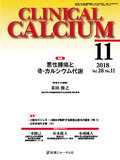Japanese
English
- 有料閲覧
- Abstract 文献概要
- 1ページ目 Look Inside
- 参考文献 Reference
骨はエストロゲン受容体陽性乳がんが最も転移しやすい臓器である。そのため骨転移が成立する機序を解明して,有効な治療法さらには予防法を開発することが重要である。放射線治療や手術および薬剤を組み合わせた治療によって骨転移治療の成績は明らかに進歩している。その中で骨修飾薬が最も重要な役割を果たしている。現在,ビスホスホネート(BP)製剤のゾレドロン酸(ZOL)と,receptor activator of NF-κB ligand(RANKL)に対する完全ヒト型モノクローナル抗体のデノスマブ(Dmab)が広く使用されている。これらの骨修飾薬の登場によって明らかに骨転移症例のQOL(quality of life)は改善している。さらにこれらの薬剤は骨転移の予防や予後の改善効果も期待されている。どちらも安全な薬剤であるが,顎骨壊死や低カルシウム血症,腎障害や非定型骨折など頻度は少ないが重篤な副作用には注意を要する。
The bones are the most common organ where estrogen-receptor positive breast cancer tends to metastasize. Thus, it is important to treat and prevent bone metastases by studying pathogenesis of developing metastasis to the bones. As advancing treatments have significantly improved the quality of life in patients with bone metastases of breast cancer. Among them, bone-modifying agents have been playing the most crucial roles by reducing the rate of skeletal related events and also having a possibility of favorable effects on prognosis. Zoledronic-acid and denosumab are currently available and denosmab seems to be superior to zoledronic-acid in inhibiting osteoclastic activity. Although both of these are safe drugs, several rare but serious adverse events need to be cautious like osteonecrosis of the jaw, hypocalcemia, renal dysfunction and atypical fracture.



